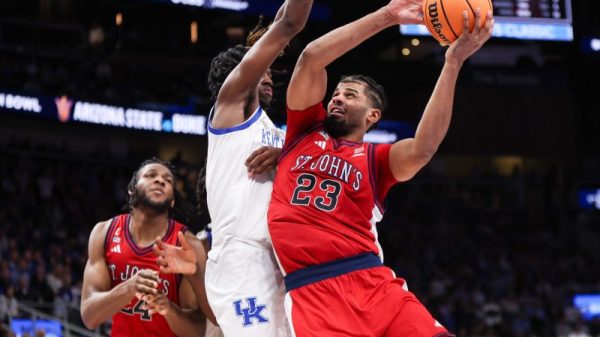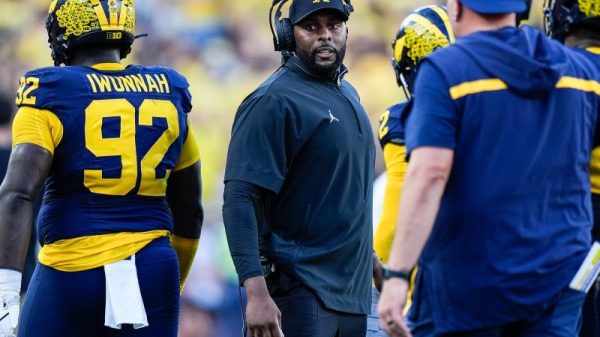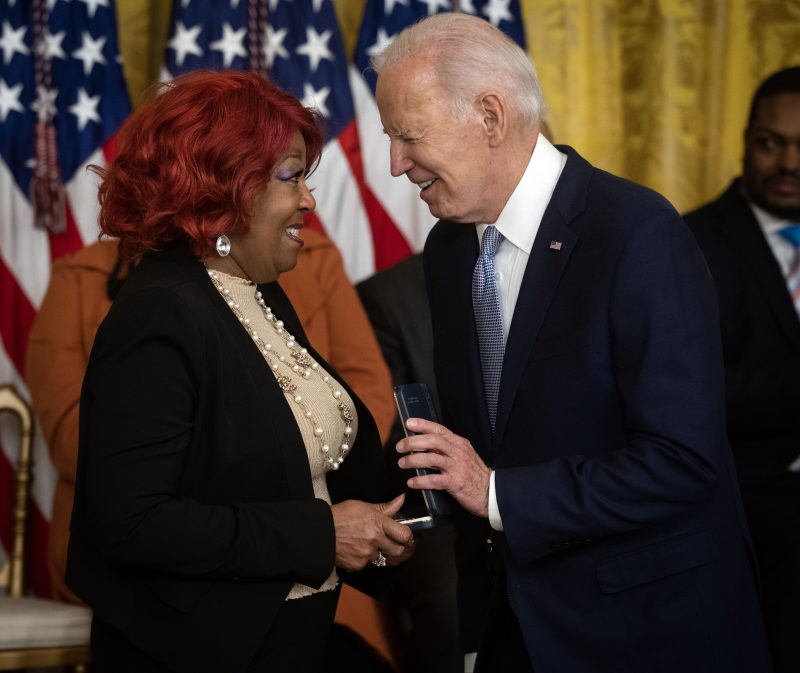Former president Donald Trump turned to his social media platform Truth Social this week to attack a familiar target: former Georgia election worker Ruby Freeman.
Trump’s posts stoked an old baseless claim that Freeman was part of an election-rigging scheme that cost him the election — false claims that two years ago led to a torrent of harassment and death threats against Freeman and her daughter, Shaye Moss, who was also an election worker.
“What will the Great State of Georgia do with the Ruby Freeman MESS?” Trump said in a post on Tuesday. “Why not just tell the TRUTH, get rid of the turmoil and guilt, and take our Country back from the evils and treachery of the Radical Left monsters who want to see America die?”
Freeman’s lawyer, Von DuBose, said in a statement that the claims that Freeman was involved in falsifying ballots “have been proven false over and over again” but that her life has been upended and she still feels threatened.
“Nobody, not even a former president, has a right to intentionally spread damaging, defamatory lies about fellow citizens,” DuBose said.
It’s not the first time in recent months that Trump has used Truth Social to spread false accusations about the 2020 election. Since the 2022 midterms, when some Trump-backed candidates lost their races, the former president has taken to his platform regularly to assert that the last presidential contest was plagued by widespread voter fraud or that the election was stolen.
But his comments about Freeman, who told the House committee investigating the Jan. 6, 2021, at the U.S. Capitol that she was forced from her home of 20 years because of the harassment she experienced after the 2020 vote, illustrate the predicament facing Meta as the social media giant weighs whether to restore Trump’s access to his social media megaphone.
Meta suspended Trump indefinitely on Jan. 7, 2021, following his praise and encouragement of rioters who stormed the Capitol. The company’s Oversight Board, an independent group of human rights experts, academics and lawyers that issued binding rulings on some of Meta’s content moderation decisions, later upheld the suspension but criticized the company for not establishing criteria for suspending a user indefinitely.
The company then shortened the suspension to two years and said, when that period was over, it would assess whether the public safety risk had subsided enough to restore his account. Those two years end Saturday.
For now, Trump’s account remains suspended. Meta spokesperson Andy Stone said in a statement that the company “will announce a decision in the coming weeks in line with the process we laid out.”
Where Meta comes down on that decision could have widespread ramifications, experts say. While the country isn’t experiencing the same threat of a violent political insurrection that characterized the weeks leading up to Jan. 6, Trump’s rhetoric about election fraud — and the movement of people that were inspired by his remarks — continues to percolate online. That should be enough, some argue, to keep him off the platform.
Others say that without the threat of imminent violence, Meta could be make the case that Trump’s account should be restored. They note that with Trump already declaring his 2024 candidacy for president, continuing his suspension would constitute an unprecedented restriction of the digital speech of a major American presidential candidate.
“These platforms are in a difficult position of deciding whether they’re going to make their audience available only to one candidate but not another,” said Nate Persily, a professor at Stanford Law School who specializes in election issues and free speech.
Meta’s decision could influence other social media companies that also suspended Trump’s account indefinitely, such as YouTube. And it may set precedent for how digital platforms treat other world leaders.
“There are plenty of places around the world where there’s constant violence that is being incited by leaders,” Persily said. “The question has always been: Is this a unique decision for Trump, or is this actually an interpretation of community standards that apply worldwide?”
Meta’s decision is also likely to reverberate elsewhere, including in Congress and statehouses where Republicans are pushing for greater restrictions on what social media companies can decide to allow on their sites.
Democratic lawmakers including Rep. Adam B. Schiff (Calif.) and Sen. Sheldon Whitehouse (R.I.) urged Meta last month to extend Trump’s suspension.
“Trump has continued to post harmful election content on Truth Social that would likely violate Facebook’s policies, and we have every reason to believe he would bring similar conspiratorial rhetoric back to Facebook, if given the chance,” the lawmakers wrote in a letter to Meta.
The final report of the House committee investigating Jan. 6 encouraged congressional committees to examine social media companies whose policies have “have had the effect of radicalizing their consumers, including by provoking people to attack their own country.” But there’s no consensus in Congress for such an examination, and a more detailed assessment of what role social media played in the Jan. 6 violence was left out of the committee’s final report.
Trump’s online posts that led to his suspension are not in dispute. As a mob forcibly entered the Capitol, Trump addressed the rioters in two separate posts: The first was a video posted on both on Facebook and Instagram in which he repeatedly said the election was “stolen” but told the protesters to go home. Facebook removed the post for violating its rules against praising people or groups that had been placed on its list of dangerous individuals and organizations.
Later that evening, as police secured the Capitol, Trump posted a written statement on Facebook claiming that “a sacred landslide election victory” had been “viciously stripped away from great patriots who have been badly unfairly treated for so long.” He later told them to go home but to remember the day forever. Meta removed that post, too, for violating its rules and blocked him from posting for 24 hours. The next day, the company suspended Trump indefinitely.
Five months later, the Oversight Board said it was inappropriate for the company to impose an indefinite suspension with no criteria for when or whether the account could be restored.
In its ruling, the Oversight Board noted that heads of state and other top government officials can have greater power to cause harm than other people and that Meta should suspend their accounts for a period sufficient to protect against imminent harm. The Oversight Board was created and funded by Meta but issues binding rulings on its decisions to leave up or take down content, and makes general recommendations on the company’s policies that are not binding.
The following month, Nick Clegg, Meta’s president of global affairs, said in a statement that the company would give Trump a two-year suspension that would only be lifted if “the risk to public safety has receded.”
Clegg, who has taken on an increasingly visible role in overseeing the company’s public policy decisions, said then that after the two-year period, the company would turn to experts to assess whether the risk to public safety has receded. He added that the company would take into consideration “external factors, including instances of violence, restrictions on peaceful assembly and other markers of civil unrest.”
Clegg also said that when Trump’s suspension is “eventually” lifted, the former president would face “a strict set of rapidly escalating sanctions,” including up to permanent removal of his pages and accounts if he continues to violate the platform’s rules.
Since then, there has been little consensus among tech companies or academics about the best way to treat world leaders like Trump who break the rules. For instance, a minority on the Oversight Board recommended that users who seek to have their accounts restored should have to “recognize their wrongdoing and commit to observing the rules in the future.”
Some argue that Meta could make the case to bring Trump’s account back because the dangerous political conditions that led up to the Jan. 6 insurrection have dissipated. There were few reports of violence at rallies Trump held in the lead-up to the 2022 midterms as part of his aggressive push to boost the candidates he’d endorsed, and many of the electiondeniers who lost conceded their elections without resorting to violence. Even in Arizona, where Republican gubernatorial candidate Kari Lake refused to concede, demonstrations in her favor were described as poorly attended.
But some advocates and analysts caution against drawing too many conclusions from the lack of violence during the midterms, because presidential races have a way of focusing the public’s attention on political movements that congressional races do not. With new owner Musk’s decision in November to restore Trump’s Twitter account, as well as those of hundreds of others banned for violating the rules, a decision by Meta to allow the former president to post once again would restore his power to influence extremists in dangerous ways, they say.
“Is [Trump’s rhetoric] safer, or is it that it wasn’t being broadcast to hundreds of millions of people on Facebook that kept it safer?” said Accountable Tech’s executive director, Nicole Gill, whose anti-Big Tech advocacy group has run digital and television advertisements urging the company not to reinstate Trump. “The absence of violence after the midterms is not at all reason to let him back on.”
Trump’s posts on Truth Social, the Twitter clone created after he left office, offer a window into the kind of content he might share on Facebook if he were allowed to post again. Last month, Trump said he “devoured” Democrats in 2016 “and again, with much bigger numbers, in 2020, but that Election was RIGGED. MUST DO IT AGAIN!” In November, Trump amplified a meme that said: “MOST COULD SEE THAT TRUMP CLEARLY WON, BUT WHAT EVEN MORE DIDN’T SEE, WAS HOW MUCH CORRUPTION WE THE PEOPLE ARE UP AGAINST.”
Experts say it’s not realistic to expect Trump to drop a theme he has maintained consistently since losing the 2020 election. “The idea that he is going to go back on Facebook and never mention that he thinks the results of the 2020 election were fraudulent is probably really unlikely,” said Joshua Tucker, a politics professor at New York University who studies social media issues.
“I’m sure he’s going to say things that are going to lead to howls of protest from lots of other people who say, ‘Well, you let him back on if he didn’t do X and he just did X, so got to kick him off now.’ So again it’s kind of a lose-lose situation,” Tucker said.
But he added that the bigger unknown might be whether Trump chooses to use Facebook at all even if he is reinstated. Trump so far has not used his restored Twitter account, perhaps mindful that his ownership agreement with Truth Social calls for him to post to it first. Whether he changes his approach to social media during a heated campaign for the presidency remains an open question. Trump could benefit financially if Truth Social takes off in popularity, but he will be able to reach far more people and better tailor his advertising campaigns if he uses Facebook.
“That’s the super interesting question,” Tucker said. “If they let him back on, what does he actually do about it?”



























